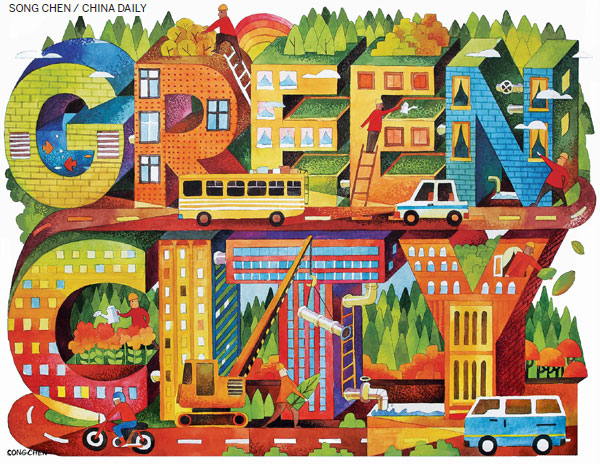
African city leaders have been looking at China, and Shanghai in particular, as worthy of emulation
Even as Africa looks to China as an exemplar while the continent's industrialization continues apace, it also hopes to avoid some of the costly mistakes China inevitably made in more than 30 years of rapid economic growth.
Chief among these are the heavy environmental costs that China, mainly its biggest cities, have had to pay. Africa is only too well aware of these problems, particularly as it, like China, pushes ahead with urbanization that is seen as a key to fueling its economic growth.

"China and African countries are experiencing similar growing pains as urbanization progresses," says Wu Jiang, vice-president of Tongji University of China in Shanghai.
"Green urban planning can help ease that pain."
Some of the most important players in ensuring that urbanization is planned successfully are, obviously, city leaders, and eight of those from Africa were at Tongji University over eight days from March 18 to discuss planning greener cities and to talk about how developing countries in particular can help one another.
These city leaders - from Yaounde, Cameroon; Abidjan, Cote d'Ivoire; Niamey, Niger; Kampala, Uganda; Lusaka, Zambia; Harare, Zimbabwe; Addis Ababa, Ethiopia; and Kiambu county, Kenya - were among 25 delegates to the conference organized by the university, the United Nations Environment Programme and the UN Human Settlements Programme, also known as UN-Habitat.
"We are here to discuss how to make cities greener and more efficient," said Patrick Mwesigye of the regional office for Africa of the UNEP, as the gathering opened.
The venue for the meeting was no accident, given that Shanghai is seen as a prime example in China of both the problems and the solutions that urbanization presents.
Shanghai, the largest industrialized city in China, and with a population of 24 million, has been particularly hard hit by environmental pollution, which has put extra pressure on it to develop a green economy.
"Shanghai has done so much in terms of development, growth and infrastructure and also the capacity of technology in universities," says Munyaradzi Chenje, director of the UNEP's regional support office.
"There is a lot to learn for cities in different parts of the world which face similar challenges, but on a much smaller scale, than Shanghai."
In 1985 China's urbanization rate was below 25 percent, but by 2013 it had shot up to 53.7 percent. This urbanization has been accompanied by increased traffic congestion, pollution and inefficiency in harnessing and allocating resources.
But Shanghai and indeed China are not unique in grappling with these problems of urbanization. More than half the world's population is now reckoned to live in urban areas, and it is estimated that there will be 5 billion such people in 2030, says Axumite Gebre-Egziabher, director of UN-Habitat's regional office for Africa.
Ninety percent of urban population growth between now and 2030 will take place in developing countries, with the highest urbanization rate observed in Africa, she says.
"Many cities were planned for smaller populations. We have to work on planned expansion."
Cities are the biggest contributors to global warming, emitting as much as 70 percent of human-induced greenhouse gases, and many lack access to water, sanitation and waste management, Gebre-Egziabher says. Many of these cities are also vulnerable to natural disasters promoted by climate change such as storms and floods.
Experts say the key to forestalling such eventualities and providing livable environments comes down to planning well in advance. For example, public transport can be run very effectively in cities that are compact, meaning the number of motor vehicles and the resulting greenhouse gas emissions can be reduced.
For more than 20 years the UNEP and UN-Habitat have worked together to promote environmental sustainability in urban development, and last month's Tongji University gathering was part of their Greener Cities Partnership program.
The UNEP has also formed a long-term relationship with the Ministry of Science and Technology and the university. In 2002, the UNEP-Tongji-Institute of Environment for Sustainable Development was set up to train people in handling global environment issues and sustainable development matters.
The Tongji gathering looked at three major issues: resilient, resource-efficient cities; sustainable transport and mobility; and solid waste and wastewater management. Experts from Tongji and other Chinese institutions showcased efforts of Chinese cities in tackling these issues.
"We really hope Africa can learn from us on industrialization and urbanization," says Li Fengting, professor and vice-dean of the Institute of Environment for Sustainable Development. He stresses the importance of engaging mayors in discussions.
"They are the decision-makers on the forefront of urban planning."
During the gathering, participants saw first hand the water management system in the neighboring city of Kunshan and visited the Shanghai Urban Planning Exhibition Hall.

Phillip Pfukwa, director of works of Harare, says the gathering underlined for him the importance of development taking place without damaging the environment.
"It has really shown the stages China has gone through, from being a very underdeveloped country to the second-biggest economy in the world."
Potpher Tembo, vice-mayor of Lusaka, says: "Sooner or later we may go through what China has gone through."
Lusaka is plagued by traffic congestion, he says, and he regards steps Shanghai has taken to deal with the issue, such as improving public transport and discouraging the purchase of cars by raising the price of number plates,, as offering a template.
"In Lusaka you find that sometimes one person owns five or six vehicles. We need to control that. If we don't do something now, heavy economic problems lie in store."
He is also concerned about how to manage waste in the city because improper dumping may cause diseases such as cholera, he says.
Far from being restricted to just airing problems related to growth, the gathering also provided opportunities for Chinese and African leaders to talk about how they are working together in other ways.
They heard of: Jiangsu Nantong No 3 Construction Group, in Haimen, a city 50 kilometers north of Shanghai, whose two pillar industries are construction and textiles, that has worked on several construction projects in Africa; Yixing, a city in Jiangsu province that is strong in manufacturing environmental protection equipment and solar energy materials; and Anji county, a small city in Zhejiang province, which has more than 666 square kilometers of bamboo. It has developed bamboo-related industries, from planting and processing of bamboo to tourism, and UN-Habitat has declared it to be one of the world's greenest cities.
Delegates from Kenya expressed interest in Anji's bamboo industry, and in fact a bamboo-related project has already been set up in the country.
"We are looking forward to getting advice on bamboo," says Gerald Gakuha Githinji, vice-governor of Kiambu county. He talks of the possibility of working with Haimen in textiles, too.
Bernard Manyenyeni, mayor of Harare, says more can be done with solar energy in Africa, given the continent's copious sunshine.
Tembo of Lusaka invites investors to his city to build factories, rather than putting their money into restaurants and shops.
He Xiaojin, vice-mayor of Yixing, says that 10 or 20 years ago his city faced problems similar to those of Lusaka in soliciting investment.
"We went to developed countries to invite investors to build factories in our city. But there were so many things investors needed to consider before they took the plunge. Many of China's industries need to go overseas, but there is still a huge gap in understanding between Chinese cities and African ones."
Chinese mayors reminded their African counterparts that the ready availability of skilled workers, and businesses being given the appropriate support, play important roles in investment decisions.
There were calls at the gathering for more collaboration in higher education between China and Africa, and African cities were said to need more specialists in engineering and urban planning as urbanization unfolded.
"Universities have a strong role in development," says Nakano Tata Ousmane of Niamey, Niger. He hails the investment from China that has contributed to his country's growth but says that once Chinese leave after working on projects, the country lacks skilled people to do maintenance work.
More engineers need to be trained with the help of Chinese universities, Tembo says.

There have been exchanges at the college level between China and Africa over many years, including the 20+20 Cooperation Project among Chinese-African universities, which was set up in 2009. Twenty Chinese academic institutions, including Peking University, Southeast University and Shanghai Normal University, have partnerships with 20 African universities such as Makerere University in Uganda and the University of Dar es Salaam in Tanzania. The project covers joint academic research and human resources training for Africa.
Tongji University has been involved in exchanges of knowledge and expertise with African universities and training African students. The Institute of Environment for Sustainable Development has offered environment and urban planning related degree programs to international students since 2006. So far 153 from 47 countries, including Ethiopia, Kenya, Sudan and other African countries, have been accepted in these programs. They host workshops on water management and treatment in African countries. The most recent was held immediately after the Tongji gathering.
Li of the institute, said at the gathering that Tongji is ready to work with more African universities in undergraduate and graduate education.
"We are thinking of a 4+1 mode, where students spend four years in Africa and one year in Tongji."
Representatives from Jiangsu Nantong No 3 Construction Group, Nanjing Yangtze State-owned Investment Group and other Chinese enterprises also attended the Tongji gathering.
African delegates were later invited to Chinese cities to find out more about local industries and about the needs of Chinese businesses.
lixueqing@chinadaily.com.cn
|
Gerald Gakuha Githinji, vice-governor of Kiambu county, Kenya. Photos by Gao Erqiang / China Daily |
|
Nakano Tata Ousmane, mayor of Niamey, Nigeria. |
(China Daily Africa Weekly 04/17/2015 page1)








